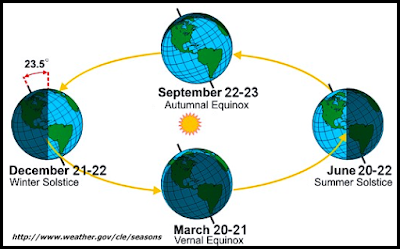The Solstices and The Equinoxes

The Solstices The times when the Sun is at its furthest from the celestial equator are called the summer and winter solstices and these occur in mid-summer and mid-winter. The world 'solstice' comes from the Latin solstitium meaning 'Sun stands still' because the apparent movement of the Sun's path north or south stops before changing direction. Figure: Equinoxes and solstices Summer Solstice: On 21st of June the sun's rays are vertical over the Tropic of Cancer as the north pole of the Earth is inclined at its maximum towards the sun. At this time, the North Pole experiences a long continuous day and the South Pole a long continuous night (ergo, what we know as summer solstice). The northern hemisphere has the summer season at this time and the southern hemisphere experiences winter now. Also the days are longer than the nights in the northern hemisphere at this time. Winter solstice : On December 22, the position of the earth with...